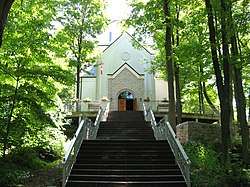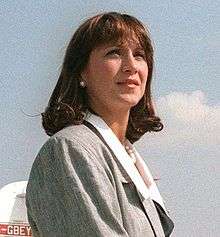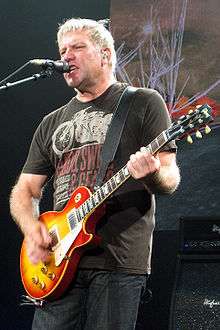Serbian Canadians
The community of Serbian Canadians (Serbian: Канадски Срби/Kanadski Srbi) includes Canadian citizens of Serb ethnicity (by birth or descent), or people born in Serbia who permanently reside in Canada. Serbs (and Serbians) have migrated to Canada in various waves during the 20th century. The 2016 census recorded 96,530 people in Canada declaring themselves as "Serbian."[1]
 | |
| Total population | |
|---|---|
| 96,530 (2016)[1] | |
| Regions with significant populations | |
| Ontario, Alberta, British Columbia, Saskatchewan, Yukon[2] | |
| Languages | |
| Canadian English and Serbian | |
| Religion | |
| Serbian Orthodox Church | |
| Related ethnic groups | |
| Serbian Americans, Montenegrin Canadians, Yugoslav Canadians |
| Part of a series of articles on |
| Serbs |
|---|
 |
|
Native communities
|
|
|
|
|
|
Related groups |
History
The first Serbs to arrive in Canada came to British Columbia between 1850 and 1870. Many were employed in mining or forestry near such towns as Phoenix, Golden, Prince Rupert and Kamloops. In Dawson City and Whitehorse names like Black Mike Winage and pioneer Miloš "Big Mike" Tadich (1887-1960) became legendary. During the Great War, Tadich fought overseas with The Seaforth Highlanders of Canada along with other Serbian Canadians, most of whom were born in Montenegro and Serbia. Those who were born in Austria-Hungary were incarcerated in Ukrainian Canadian internment camps throughout the country.
By 1900, Serbs began to arrive in Alberta. Many of these early settlers had migrated north from the north-west region of the United States. Coal mining attracted them to Lethbridge, while road construction was a source of employment for those in Macleod and Cadomin. Many Serbs worked on the construction of railway lines that now extend from Edmonton to the Pacific coast. Others were interned in labour camps as "enemy aliens" simply because they were born under the sceptre of Austria-Hungary, an empire at war with the United Kingdom and Serbia during World War I. Luigi von Kunits, who was living and working in Toronto at the time and who went on to become the founder and conductor of the Toronto Symphony Orchestra, was one of its victims had to identify himself regularly at the police station throughout the war years.
Čedomilj Mijatović became very active at the beginning of the First World War. He wrote many letters and articles to British dailies but his most remarkable action in this field was his visit to the United States and Canada. He was accompanied by the most famous British suffragette, Emmeline Pankhurst, who championed the causes of Britain's small allies (Belgium and Serbia) during World War I. A visit to the United States of America and Canada with such a well-known person caused such a sensation, brought crowds to Mijatović's lectures, and enabled him to have well-attended lectures and to give interviews to the leading dailies.[3]
The period between the two World Wars witnessed a major increase in Serbian immigration to Canada, mostly after the breakup of the Austro-Hungarian Empire. More than 30,000 Yugoslavs came to Canada between 1919 and 1939, from the Balkans, Hungary and Romania, this included an estimated 10,000 Serbs. Many of these immigrants were single, working men who had left families in their home country to seek work in Canada. The vast majority of Serbs arriving between the wars settled in Ontario or British Columbia. During this time, ties to Europe were strong and pressure from Belgrade and Ottawa resulted in certain Serbian Canadian newspapers being banned.[4] The banned newspapers were promoting communist ideas and they were mostly written by pro-Russian Yugoslavs who were not necessarily of Serbian origin.
Major changes occurred in Yugoslavia during World War II. The newly established communist government was opposed by many Serbs and Yugoslavs. Many POWs and post war refugees refused to return to their homeland to live under a communist regime. These Serbs, part of what is now called the Chetnik immigration, emigrating to Canada at this time, came from a variety of occupational backgrounds, including military and academic professions and the skilled trades. Among them were intellectuals Adam Pribićević, Miloš Mladenović, Dimitrije Najdanović. Montreal surgeon Dr. Dragutin (Drago) Papich, Professor Sava Bosnitch (father of John Bosnitch) of the University of New Brunswick and president of the Canadian Association of Slavists (in 1972 and 1973).
In the late 1980s, Yugoslavia's communist government was on the verge of collapse. Shortly after the breakup of Yugoslavia in 1991, a large group of Serbs moved to Canada, mostly to Southern Ontario, to cities including: Toronto, Kitchener, St. Catharines, Hamilton, Niagara Falls, London and Windsor. This was a major brain drain; with educated Serbs fleeing serious economic problems and an undemocratic government.[5]
Serbian Canadians protested the NATO bombing of Yugoslavia which lasted from March 24 to June 10, 1999.[6]
On October 26, 2004 at an unveiling by Toronto City Councillors Joe Mihevc and Howard Moscoe, a street in Toronto was renamed Beograd Gardens to honour Serbia's capital of Belgrade.[7] The street is located north of Eglinton Avenue and west of Marlee Avenue.
In 2016, a boulevard in Hamilton was named after Nikola Tesla.
Demographics
Officially there were 96,530 people in Canada who identified themselves as wholly or partly "Serbian" in the 2016 Census. However, this number may be much higher as there are some 38,480 people who identify as Yugoslavs in Canada, many of whom may be Serbs.[1] The major center of Serbian settlement in Canada is Toronto, which is home to 19,375 Serbs in the city proper and 33,055 in the CMA.[8] Other Serbian strongholds include Hamilton, St. Catharines, Niagara Falls, London, Regina.
| City | Population | Serbian population (2016) |
|---|---|---|
| Toronto | 2,731,571 | 25,160 |
| Vancouver | 631,486 | 7,690 |
| Edmonton | 932,546 | 3,420 |
| Calgary | 1,239,220 | 3,205 |
| Windsor | 217,188 | 2,875 |
| Montreal | 1,704,694 | 2,225 |
| Ottawa[9] | 933,596 | 1,800 |
Serbs of Toronto
The Serbs of Toronto (Serbian language: Срби у Торонту, Srbi u Torontu) are an ethnic minority that make up 25,160 people in the City of Toronto.[8]
History
One of the first Serbian immigrants in Toronto was Sremac Herceg, who arrived in August 1903.[10] A great number of Serbian settlers who came in 1912 were from the Niš region. Between the Balkan Wars and World War I, more than two hundred Serbs lived in Toronto.[10]
Culture

In 1954 the Serb Youth Club in Toronto was formed, and its folk-dance group Stražilovo became one of the first highly successful dance groups in Canada.
Toronto's folk-dance group Hajduk Veljko (founded in 1964) danced at the Montreal Olympics in 1976 and at Expo '86 in Vancouver, and Toronto's Oplenac (1973).[11]
From the early 1950s to 1984 the Serbian Cultural Club St Sava was active in Toronto, publishing eight volumes in Serbian dealing with Serb history.
In 1968, the Saint Michael the Archangel Serbian Orthodox Church hosted the "Belgrade" pavilion of the Toronto Caravan cultural festival, organized by the late Colette Sekulovich (née Leroy) which displayed many Serbian cultural artifacts, showcased Kolo dancing and other performance arts, and gave the people of Toronto a chance to taste Serbian delicacies. The annual festival ran for over 30 years, winning, in 2001, the Zena Kossar "Best Pavilion Award".
The Serbian Heritage Academy (Srpska Nacionalna Akademija), initiated, founded and spearheaded by Sofija Skoric in Toronto in 1981, has organized academic conferences, exhibits, and lectures. In 1984 it installed a bronze plaque at the University of Toronto's Medical Sciences Building honouring Canadian doctors and nurses who had worked as volunteers in Serbia during World War I.
The Serbian Cultural Association Oplenac was founded in 1987 in Mississauga, Ontario, Canada. Serbian folk dancing has been a major activity in SCA Oplenac since its inception as a non-profit organization. All proceeds from its events go to the preservation and presentation of Serbian culture and tradition in North America. In 2012 the company consisted of 8 large ensembles, choir and orchestra as well as a large recreational ensemble. They established a drama school for children that performs theatre plays in Serbian language, as well as a Serbian language school. Since 2000 it has been clear that the association is undoubtedly the biggest Serbian folklore group in North America.[12]
Serbian Theatre Toronto (Srpsko pozorište Toronto) was established in 2004 and is the oldest Serbian theatre in Canada and North America. In more than ten years of activity, the theatre has produced more than twenty plays by Serbian writers. The group has more than 20 members, but has had three times as many in the past. Serbian Theatre Toronto has performed in many cities in Canada and the USA.[13]
The first Serb bookstore, Serbica Books, was opened in 1990 by Živko Apić and was located at 2465 Dundas Street West in Toronto.
Established in 2008, Toronto's Pulse Theatre (Пулс Театар) is the biggest drama club and theatre for children in Serbian language in Canada.[14]
Serbian Toronto Television is a weekly 30-minute current affairs Serbian television show that is filmed throughout various locations across Canada and Serbia and airs on multicultural channel Omni Television.
Media
Places of worship
- Holy Transfiguration Monastery (Milton, Ontario)
- All Serbian Saints Serbian Orthodox Church (Mississauga)
- Saint Sava Serbian Orthodox Church (Toronto)
- Saint Michael the Archangel Serbian Orthodox Church (Toronto)
- Saint Arsenije Sremac Serbian Orthodox Church in Whitby, Ontario
- Saint Petka Serbian Orthodox Church in Lakeshore, Ontario
Notable people
.jpg) |  |  |  |  |
.jpg) |  |  | _(cropped)_-_Stana_Katic.jpg) | |
 |  | _(36143091586).jpg) |  |  |
See also
| Wikimedia Commons has media related to Serbian diaspora in Canada. |
References
- "Census Profile, 2016 Census". Statistics Canada. Retrieved 11 March 2018.
- Tomovic, Vladislav A. Canadian Serbs: A History of Their Social and Cultural Traditions (1856-2002). Fonthill, Ont.: Batlik, 2002. 216-17. Print.
- "Serbia's Aged Envoy talks of his Nation", The New York Times, January 23, 1916, p. SM 4.
- Tomovic, Vladislav (1982). "Serbian press in Canada, 1916-82". Polyphony: The Bulletin of the Multicultural History Society of Ontario. 4 (1): 87. Retrieved 2 August 2013.
- Judah. The Serbs. Yale University Press. ISBN 978-0-300-15826-7.
- CBC (1999-03-26). "Serb-Canadians protest NATO intervention". Retrieved 2020-07-17.
- Novine Toronto (28 October 2004). "Zvanično otvorena ulica Beograd Gardens, pg. 15" (in Serbian).
- "Statistics". www12.statcan.gc.ca. Retrieved 11 March 2018.
- "Census Profile, 2016 Census - Ottawa [Economic region], Ontario and Ontario [Province]". 2.statcan.gc.ca. Retrieved 2018-05-27.
- "Serbian Orthodox Diocese of Canada : Synaxis of All Serbian Saints Church : Parish West Toronto - Mississauga". sabornik.com. Retrieved 20 August 2017.
- "Archived copy". Archived from the original on 2012-07-13. Retrieved 2008-07-14.CS1 maint: archived copy as title (link)
- "Serbian Folklore and Serbian Dancing in Canada". Oplenac.ca. Retrieved 20 August 2017.
- Archived 2016-01-29 at the Wayback Machine
- "Пулс Театар". Pulsteatar.com. Retrieved 20 August 2017.
- "Novine Toronto". Novine.ca. Retrieved 20 August 2017.
- "Vesti online - Srpski informativni portal". Vesti-online.com. Retrieved 20 August 2017.
- Archived 2008-10-25 at the Wayback Machine
- "Home - Serbian Toronto Television - Srpska Televizija Toronto". Serbian Toronto Television - Srpska Televizija Toronto. Retrieved 2016-01-27.
Sources
- Vuković, Sava (1998). History of the Serbian Orthodox Church in America and Canada 1891–1941. Kragujevac: Kalenić.CS1 maint: ref=harv (link)
- Powell, John (2005). Encyclopedia of North American Immigration. Infobase Publishing. Retrieved 20 April 2013.
